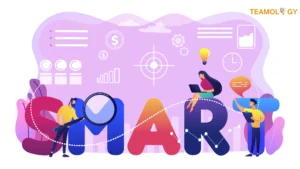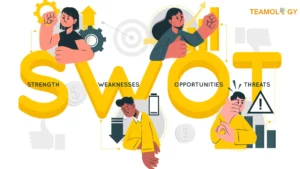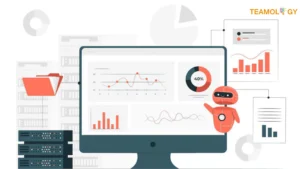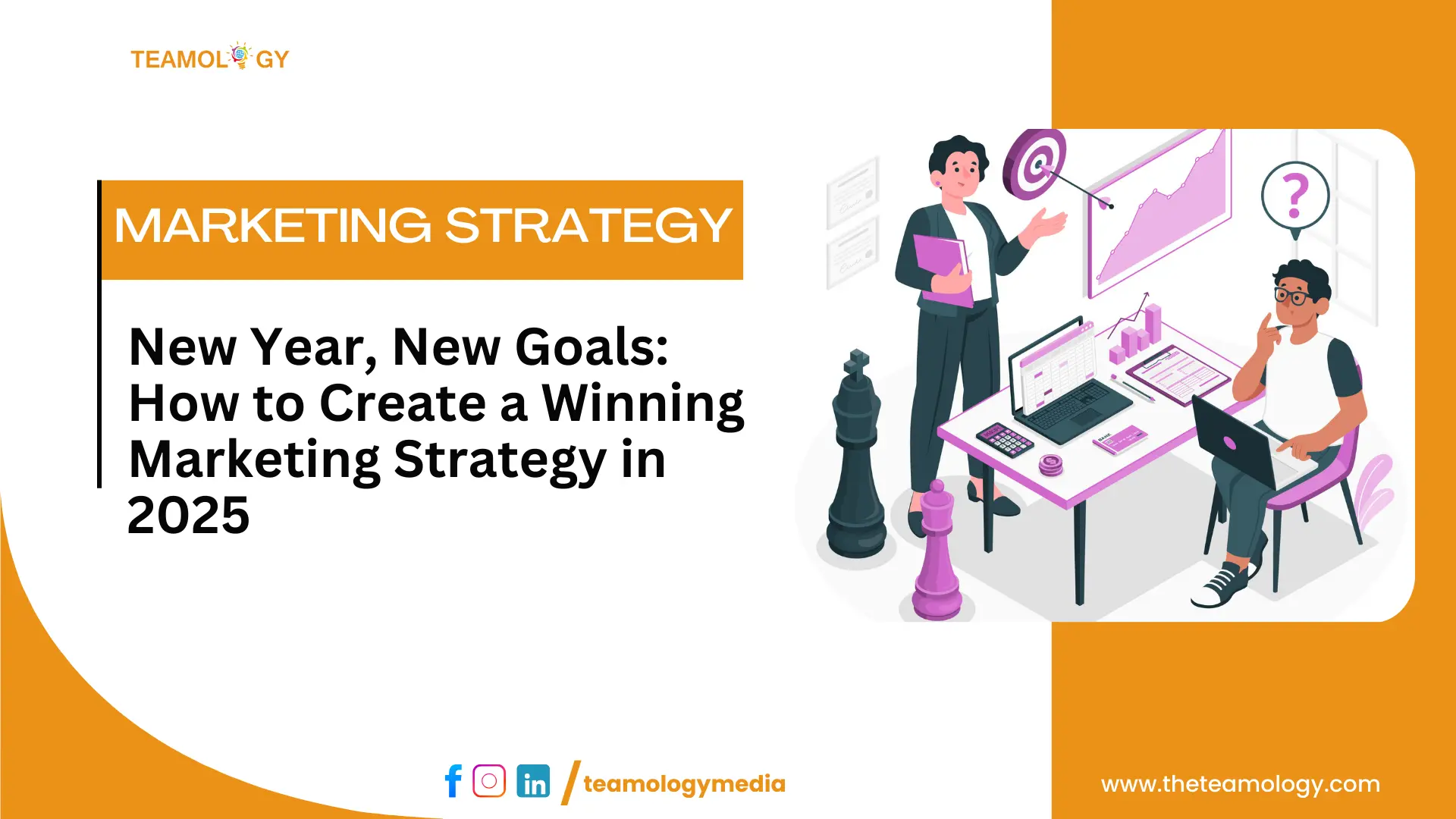A new year brings new goals for your business. Just take a moment and think: How effective was your marketing strategy last year? Perhaps a few plans worked well, but now nothing works like before. Can’t you see a genuine need to upgrade your tactics here? You know what, you need a fruitful marketing strategy in 2025.
Let’s assume Priya is an entrepreneur running a thriving e-commerce store. However, by the end of 2024, Priya realizes her existing marketing strategies are no longer delivering. Last year’s ploys failed to attract fresh customers. She needs to follow shifting trends to sustain her business, so she decides to start fresh in 2025.
Just like Priya New Year can offer great opportunities for you too. This is the perfect time to realign your marketing objectives. You can embrace digital and consumer behavioral changes to grow your business.
In this blog, we will prepare you for your marketing strategy in 2025 with a step-by-step comprehensive guide. We promise you won’t leave this page without knowing how to set a winning marketing strategy for your business.
1. Understand Why Marketing Strategy Matters in 2025
Definition of Marketing Strategy:
Marketing strategy means making plans and taking steps to achieve business goals.
In simple words, it is a blueprint that will guide your business on the right track and help you develop the strategies necessary to reach your customers.
For example, if you are a product-selling business, your marketing strategy should be to:
- Find ways to take your products to the people
- Increase brand loyalty
- Ultimately boost sales
Changes Driving Strategies in 2025:
Maintaining the right marketing strategy is getting tougher. Consumer behavior, digital trends, and economic shifts impact market dynamics.
Now, customers are more tech-savvy. Social media, online shopping, and AI are helping them quickly spot their favorite items. New types of interactions and experiences have become essential for them today.
For example, in 2025, you can identify consumer preferences with AI and offer them personalized products. Not just that, many brands are now focusing on social responsibility and sustainability.
So, if your marketing strategy can’t cope with this changing landscape, you will fall behind.
Aligning Marketing Strategy with Business Goals:
Your marketing strategy is useless if it does not match your key business goals.
Suppose your primary business goal is to improve customer service or launch a new product in the market. Then, your strategy should be to focus on meeting those goals.
This will help you achieve your objectives while also increasing consumer trust in your brand. When a marketing strategy perfectly fits their business objectives, businesses are more likely to succeed.
2. Start with Clear Goals

SMART Goals
Setting SMART Goals:
Set clear goals for your business to succeed. Unclear goals may derail your efforts. Your goals should be SMART – Specific, Measurable, Achievable, Relevant, and Time-bound to achieve maximum results.
Examples of Marketing Goals for 2025:
What should be your business goals for the new year? Let’s consider some examples:
Increasing Brand Awareness – You have to reach new customers and create awareness about your brand among them. Example:
- Unclear Goal: “I want to make my brand popular”
- Clear Goal: “I will increase my social media followers by 25% in the next 6 months.”
Generating more Leads – That means increasing the number of potential customers who will be interested in buying from you. Example:
- Unclear Goal: ” We must generate more leads through our website.”
- Clear Goal: “We need to increase our email subscribers by 20% through free ebook offers on our website in the next 3 months.”
Strengthening customer retention – Build stronger relations with those who already have faith in your offerings. Example:
- Unclear Goal: ” Need to strengthen customer relationships.”
- Clear Goal: “Will make our existing customers more loyal to our brand by offering them a special monthly discount within the next 6 months.”
3. Know Your Audience Better Than Ever
Leveraging Data Analytics and AI:
Do you know businesses today can get valuable insights into customer behavior and preferences by leveraging data analytics and AI? For instance:
- What a customer is searching for most of the time or buying frequently?
- How much time he/she is spending on a specific page?
Analyzing these data allows you to know their needs. Again, by using AI you can also predict his/her next demand. This will grow your business and help you deepen your bond with them.
Segmenting Audiences:
Now let’s talk about segmentation. Different people have different choices.
Categorize your audience into segments according to:
- Their age((Gen Z, Millennials, Baby Boomers)
- Behavioral patterns
Craft specialized ads and personalized offers for them on their platforms of choice. For example:
- Flashy and interactive social media is very popular among GenZs.
- Millennials would like to seek more profound knowledge about a product. So they might prefer platforms like blog posts, email marketing, or product reviews.
Provide personalized experience to your customers. Why? Because in today’s time and age people want personal touch. When you send them personalized offers or messages understanding their needs, they will be loyal to your brand. Example:
- Send discount notifications if any customer repeatedly searches for an item.
- Mention the customer’s name in the email and offer him exclusive deals.
4. Analyze Competitors and Market Trends

SWOT Analysis
SWOT Analysis for Opportunities
SWOT analysis is very effective in discovering fresh scopes for your business. There are 4 analyses in this:
- Strengths: What is the key strength of your business? For example, cost-effectiveness or advanced customer service.
- Weaknesses: Identify how you can improve your weaker sides.
- Opportunities: What opportunities new market trends and demands are creating for you?
- Threats: Where competitors are ahead, areas where they can beat you?
This way you can avoid risks and plan your future strategies.
Using Competitive Analysis Tools
Use tools to analyze competitor’s activities. Popular tools are SEMrush, Ahrefs, and SimilarWeb.
- SEMrush: helps in analyzing competitor keywords, their ad strategies, and SEO activities.
- Ahrefs: effective for backlink analysis and developing content strategies.
- SimilarWeb: great for inspecting web traffic data and trends.
5. Build a Multi-Channel Approach
Integrating Online and Offline Strategies:
A mix of online and offline marketing strategies is paramount for your business to flourish. Today you can’t go with a digital-only or traditional-only approach.
Suppose you are launching a new product. You will attract more people if you distribute physical posters and flyers of your products in parallel with running social media campaigns.
It is easy to reach your customers online however a focus on local offline markets can help build better personal relations. With proper blending, it is possible to add a new dimension to your business.
Key Digital Channels for 2025:
There will be a rising importance of digital marketing in the coming year. Your business will grow faster if you can pay attention to the following channels:
- Social Media:
Now customers are cherishing interactive posts, reels, and short-form videos. So make creative content on platforms like Facebook, Instagram, and TikTok.
- SEO and Content Marketing:
Search engine marketing(SEO) and quality blogs or web content can improve organic traffic. For example, write blogs on keywords relevant to your products or services.
- Email Marketing and Automation:
Send personalized offers through email marketing and automation. Sending regular emails can strengthen your relations with customers.
- Traditional Media’s Role:
Many believe traditional media is now obsolete. But this is not entirely true. If you want to reach remote or local audiences TV, radio and newspapers are still very effective.
For example, give ads on local radio to target rural customers. Showcase your products at the local fairs. Combining these strategies with digital marketing can increase your brand value.
6. Content Creation: The Heart of Your Strategy
Importance of Quality and Relevance: Content quality and relevance are key in today’s time. Consumers now want content that solves their problems and keeps them engaged. People are likely to skip boring content. They want something that serves their purpose and engaging at the same time. Quality content fosters trust in your brand keeping your customers for the long run. So make sure your blogs and creatives connect with your audience.
Emerging Content Trends in 2025: Content creation is poised for some major changes in 2025. You must pay attention to them to stay ahead of the game.
- AI-generated Content:
AI is making the creation of blogs, articles, and social media posts very easy and quick. That said, AI won’t replace human touch anytime soon. - User-generated Content (UGC):
If your customers start creating reviews, and videos on your products or share your posts on social media, it shows they have more trust now in your brand. - Immersive Content like AR/VR:
Augmented reality(AR) and virtual reality(VR) based content provide exceptional experience to the people.
Tips for Effective Content Creation
How you can create effective content? Follow these tips:
- Create localized content: Create something relevant to your local language and culture. This creates a deeper connection with the customers.
- Use short and simple language: Your messages should be short, simple, and crisp enough so that everyone can understand them.
- Add visuals: Images, videos, and infographics make content more catchy.
- Choose relevant topics: Create content on subjects that your audience is searching
7. Leverage Technology and Tools

AI in Marketing
AI in Marketing:
AI has leveled up the game for marketing today. Predictive analytics is helping businesses to gauge future demands for customers. For example, using AI you can guess what your customers will choose next. You can create customized content tailored to different groups. This will make your content more relevant and increase engagement. AI is also playing a big role in customer service. Chatbots like ChatGPT can work 24/7 to solve customer problems. These bots are prompt in answering product-related customer queries.
Tools for Automation and Data Tracking:
The following tools are highly effective for marketing campaigns and performance tracking:
- HubSpot: One-stop place for email marketing, customer relations, and automation
- Salesforce: Very popular for customer data management and lead tracking.
- Google Analytics: The best tool to understand the behaviors of your online visitors and fix marketing strategies.
- Blockchain for Transparent Ad Spending:
Blockchain is bringing clarity to ad spending. This technology clearly shows where your marketing budget is going. This significantly brings down the wastage of budgets on agencies or media channels. For example: if you spend 50% of your budget on ad campaigns blockchain will generate real-time tracking reports for you.
8. Focus on Customer Experience (CX)
Why CX Will Dominate in 2025: In 2025 customer experience (CX) will emerge as a key driver for business success. Good experience makes customers return to you again and again. In a competitive market, not just products or services but CX also can be your formidable weapon to gain customer trust.
For example, consumers will pick another brand if they don’t get quick solutions or simple processes. So more focus on CX will lead to increased customer loyalty and repeat business.
Creating Seamless Experiences Across Touchpoints: Customers connect with a brand through multiple channels – websites, WhatsApp, and social media. Make sure they get the same experience at every touchpoint.
Suppose, someone is searching for a product on your website but does not finish a purchase. Later he sees a reminder of that product on your app or social media page, now he can easily buy that. Besides, maintain the quality of your services from customer support to shopping. A confidence booster for your customers and more power to your brand image.
Examples of Excellent CX: The following brands became market leaders for their expertise in CX:
- Amazon: Provides personalized experience in each step right from ordering to delivery. For example, “Those who bought this have also looked for these products.” – this feature improves CX.
- Lenskart: Lenskart’s “Try at Home” and 3D Virtual Try-On tools help customers easily choose frames. Express delivery and an easy return policy streamline their CX.
9. Social Media and Influencer Marketing
Expect some new trends in social media in 2025
Video-first content:
- More platforms(Linkedin, X) will accept short-form videos.
- Faster video editing and customization will be possible with new AI tools.
- VR features will be added to videos.
Interactive Storytelling:
Like Instagram or Facebook other platforms will also launch story and quiz features. Personalized storytelling with AI will be in trend. You will be able to change your story direction as per your choice.
Social Commerce:
Real-time buying options in live videos (Livestream Shopping) will be hugely popular. Blockchain technologies will be integrated into social commerce platforms ensuring a more transparent buying experience.
Using Influencers Effectively: Influencers are the game changers for brand promotion these days
- Choose the right Influencer: partner with micro or macro influencers keeping your target audience in mind.
- Focus on real content: ask your influencers to create credible and relevant content.
- Establish long-term partnerships: focus on longer relations with influencers instead of one-time promotions.
Best Practices for Engagement: Follow these tips to build a powerful online community:
- Share content consistently: share regular quality posts. Responde timely.
- Be active on Instagram: give replies to your followers’ comments. Talk to them directly through polls, and live chats.
- Promote user-generated content(UGC): share content created by your customers and gain their trust.
10. Test, Measure, and Adapt
Importance of Data-Driven Decisions: Data-based decisions are now vital for every business. Accurate data will help you realize what is working and what is not. Always try to improve your marketing efforts and measure results. This reduces mistakes and makes decision-making easier.
Key Metrics to Track:
- ROI (Return on Investment): Track ROI to know how much profit is made for a specific investment.
- CAC (Customer Acquisition Cost): It is also important to know what it costs to grab new customers.
- CLV (Customer Lifetime Value): You should measure the amount of business customers have given you over their entire lifespan.
- A/B Testing and Campaign Optimization:
Test two different versions with A/B testing. Optimize your campaign by analyzing which one is giving better results. For example, run two types of ads at once: images in one and videos in the other. Focus on the ad that is getting more clicks.
11. A Few Examples of Successful Marketing Strategies
Tata Tea: “Jaago Re” Campaign
Tata Tea has raised social awareness through its “Jaago Re” campaign. They brought various social issues starting from voting to the fore. The campaign was a perfect example of social awakening and boosting brand connection. People not only saw this as a beverage campaign but also as a symbol of arousing.
Bajaj Pulsar: “Pulsar Stunt Mania” Campaign
Bajaj Pulsar launched the “Stunt Mania” campaign targeting bike lovers. They were successful in attracting bike performance and bike adventure-loving youths. Bajaj was able to empower their brand reputation through Tele shows and digital media.
Your Roadmap to Successful Marketing Strategy in 2025
Businesses will have no future without a well-planned marketing strategy. To succeed in 2025, you have to develop strategies to understand customer demands. Parallely you also have to match changing trends and technologies. This not only grows your business but also creates customer’s trust in your brand.
This is the time to evaluate your marketing strategy. Drop what is not working and add fresh ideas. Take data-driven decisions, give priority to customer experiences, and make your presence stronger across multiple channels.
With a thoughtful strategy and positive mindset for the future, your 2025 might just be the beginning of a golden era for your business.


